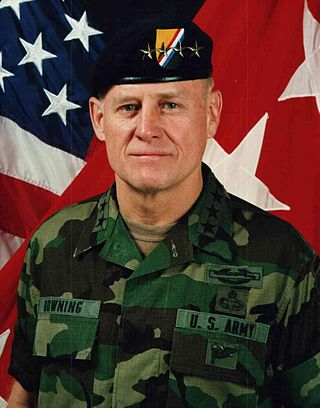
Wayne Allan Downing was a four-star United States Army general born in Peoria, Illinois. He graduated from the United States Military Academy with a Bachelor of Science degree in 1962 and held a Master of Business Administration degree from Tulane University. He also served on the board of directors at a private military company, Science Applications International Corporation (SAIC).

Lieutenant General Michael David Maples, USA served as the 16th Director of the Defense Intelligence Agency (DIA), appointed on November 4, 2005. He was promoted to lieutenant general on November 29. Maples also commanded the Joint Functional Component Command for Intelligence, Surveillance and Reconnaissance (JFCC-ISR) for the United States Strategic Command (USSTRATCOM). He transferred his Directorship of the Defense Intelligence Agency and his command of JFCC-ISR to LTG Ronald Burgess on March 18, 2009. Maples formally served as the vice director of management of the Joint Staff.

Lieutenant General Franklin Lee Hagenbeck is a retired United States Army officer who served as the 57th Superintendent of the United States Military Academy from June 2006 to July 2010. Previous to his assignment at West Point, he was the Deputy Chief of Staff, G-1 United States Army, Washington, D.C.

Lieutenant General Robert T. Clark is a retired United States Army officer.

R. Steven Whitcomb is a retired United States Army lieutenant general. He was commissioned as a second lieutenant upon graduation from the University of Virginia in 1970. In his final assignment he served as Inspector General of the United States Army.
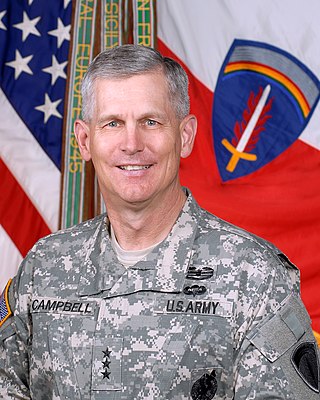
Lieutenant General Donald M. Campbell Jr. is a retired United States Army lieutenant general who served as the commanding general of United States Army Europe. He commanded the United States Army Europe from December 1, 2012, to November 6, 2014.

General William Allen Knowlton was a United States Army four-star general, and a former Superintendent of the United States Military Academy. As a full general, he served as Commander, Allied Land Forces South East Europe, and as the United States Military Representative to the North Atlantic Treaty Organization.
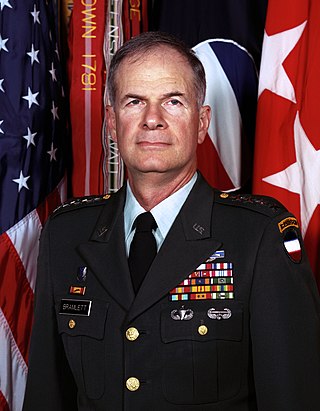
David Anthony Bramlett is a retired United States Army four-star general who commanded United States Army Forces Command from July 1, 1996 to August 31, 1998, after serving as Deputy Commander in Chief and Chief of Staff, United States Pacific Command at Camp H. M. Smith, Hawaii. During his tenure as Deputy Commander, he was the interim commander of Pacific Command after the commander, Admiral Richard C. Macke, came under fire for comments he had made in regard to the 1995 rape scandal in Okinawa that involved three United States servicemen.

Ronald Houston Griffith was an American general in the United States Army who served as Vice Chief of Staff of the United States Army (VCSA) from 1995 to 1997. He was born in Lafayette, Georgia.

Walter Thomas Kerwin Jr. was a United States Army four star general who served as Commanding General, United States Continental Army Command in 1973, Commanding General, United States Army Forces Command from 1973 to 1974, and Vice Chief of Staff of the United States Army from 1974 to 1978. He was the first commander of United States Army Forces Command and a member of the Association of the United States Army's Advisory Board of Directors since 1984.

Michael Shannon Davison was a United States Army four-star general, who served as Commander in Chief, United States Army Europe/Commander, Central Army Group from 1971 to 1975.

John Joseph Timothy Hennessey was a United States Army four-star general who served as Commander in Chief, United States Readiness Command (USCINCRED) from 1974 to 1979.
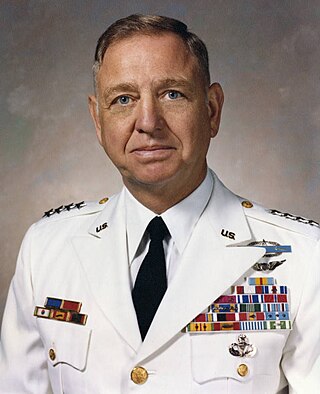
Sam Sims Walker was a United States Army general who served as the Commanding General of Allied Land Forces, South East Europe from 1977 to 1978.
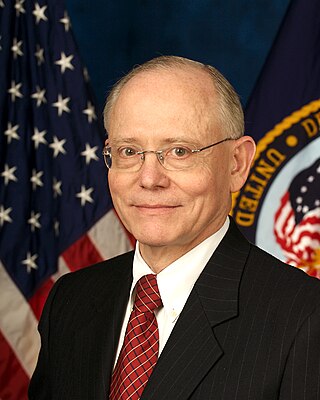
James Benjamin Peake was the sixth United States Secretary of Veterans Affairs, serving from 2007 to 2009. In 2004, he retired from a 38-year United States Army career. He also served as the 40th Surgeon General of the United States Army.

Lieutenant General Eugene Priest Forrester was a senior officer in the United States Army. He served as commander of United States Army Western Command from 1981 until his retirement in 1983.

Việt Xuan Luong is a retired United States Army major general. He is the first American officer promoted to general officer rank who was born in Vietnam. He last served as the Commanding General of United States Army, Japan/I Corps Forward. He previously served as the Deputy Commanding General (Operations), Eighth Army. His prior assignments included chief of staff of United States Army Central; Director of Joint and Integration, Headquarters Department of the Army, G-8; assistant division commander–maneuver for the 1st Cavalry Division at Fort Hood, concurrent with assignment as commander, Train Advise Assist Command – South, Resolute Support Mission Joint Command, North Atlantic Treaty Organization, Afghanistan.

Edward C. Peter II was a career officer in the United States Army. A veteran of the Korean War and Vietnam War, he attained the rank of lieutenant general and was most notable for his command of 2nd Battalion, 27th Infantry, the 1st Infantry Division Support Command, the Department of the Army Legislative Liaison Office, the 5th Infantry Division and Fort Polk, and Fourth United States Army. Peter received the Combat Infantryman Badge twice, and his awards and decorations included the Army Distinguished Service Medal (2), Silver Star (2), Legion of Merit (2), Bronze Star Medal (2), Meritorious Service Medal, Air Medal (6), and Army Commendation Medal.
![<span class="mw-page-title-main">Frederic J. Brown III</span> U.S. Army lieutenant general]](https://upload.wikimedia.org/wikipedia/commons/thumb/2/21/Frederic_J._Brown_III_%28U.S._Army_lieutenant_general%29.jpg/320px-Frederic_J._Brown_III_%28U.S._Army_lieutenant_general%29.jpg)
Frederic J. Brown III is a retired United States Army officer. A veteran of the Vietnam War, he attained the rank of lieutenant general and was a recipient of the Army Distinguished Service Medal (2), Silver Star, Legion of Merit, Distinguished Flying Cross, and multiple awards of the Bronze Star Medal. Brown is best known for his service as Chief of Armor and Cavalry from 1983 to 1986 and command of Fourth United States Army from 1986 to 1989.
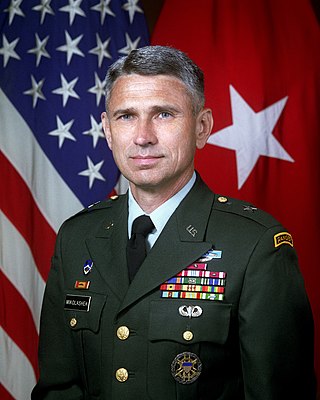
Paul T. Mikolashek is a retired United States Army officer. A veteran of the Vietnam War, he served from 1969 to 2005 and was Inspector General of the United States Army from 2002 to 2005. Mikolashek attained the rank of lieutenant general, and his awards and decorations included the Defense Superior Service Medal, Legion of Merit (2), Bronze Star Medal (2), Defense Meritorious Service Medal, Master Parachutist Badge, Combat Infantryman Badge, Ranger tab, Joint Chiefs of Staff Identification Badge, and Army Staff Identification Badge.

Robert H. York was a career officer in the United States Army. A 1938 graduate of the United States Military Academy, he attained the rank of lieutenant general, and was a veteran of World War II, Allied-occupied Germany, the Malayan Emergency, the Vietnam War, and Operation Power Pack, the 1965 U.S. intervention in the Dominican Republic during its civil war. His command assignments included the 331st Infantry Regiment, director of the Tactical Department and director of instruction at the United States Army Infantry School, director of the International Division in the army's Office of the Chief of Research and Development, director of Defense Research and Engineering for the United States Department of Defense, director of the Defense Advanced Research Projects Agency's Research and Development Field Unit and Joint Operations Evaluation Group in South Vietnam, the 82nd Airborne Division, the Infantry School, and XVIII Airborne Corps.


















![<span class="mw-page-title-main">Frederic J. Brown III</span> U.S. Army lieutenant general]](https://upload.wikimedia.org/wikipedia/commons/thumb/2/21/Frederic_J._Brown_III_%28U.S._Army_lieutenant_general%29.jpg/320px-Frederic_J._Brown_III_%28U.S._Army_lieutenant_general%29.jpg)

